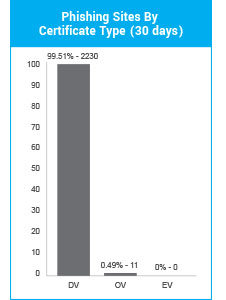Be a Shark in Today’s Phishing Pond
Would you do business with somebody you don’t trust? Neither would your customers. Phishing attacks are at an all-time high, with 1.4 million new phishing sites being created each month so they have good reason to be suspicious of any website—including yours.
When it comes to gaining your visitors’ confidence, the rules have changed. On today’s fraud-filled web—it’s no longer who you think you are, it’s who a globally trusted third-party Certificate Authority (CA) says you are.
You Can’t Earn a Premium Reputation with Standard SSL
According to a PhishLabs report, within a 30-day window, 99.5% of HTTPS phishing sites had Standard Domain Validated or DV, certificates which offer only the basic level of encryption.
Thanks to browsers labeling websites with Standard and even Premium SSL certificates as “Secure”, online customers are drawing dangerous assumptions that even phishing sites are legitimate businesses—like you. So, why would you want to display to online visitors that you have the same level of security as phishing sites?
One of our earlier blog posts summarized the important industry changes that have made basic encryption a must for all web pages. All SSL Certificates offer encryption so even blogs and personal sites can meet this new global requirement. They also all provide basic trust features—including displaying HTTPS and the padlock icon in the browser bar. But, where they really differ is in the level of validation and visual trust indicators they offer.
This is huge. Why? Because, with online customers being mistakenly led to believe that secure and safe are the same thing (which they aren’t), you need to clearly set yourself apart from hackers. That means going the extra mile to prove—based on what a respected third-party has determined—that you’re a legitimate business. The best way to do that is with an Extended Validation, or EV, SSL Certificate.
EV Isn’t an Expense—It’s an Investment
Trust can make or break you online, even if your site isn’t built for e-commerce. Here are five reasons to invest in EV SSL:
- Boost Confidence—EV enables the Green Address Bar, which is impossible to fake, making it the ultimate trust-builder. You’ll be giving your customers absolute assurance that you are who you say you are.
- Operate with Complete Authenticity—CAs only issue EV SSL Certificates after they’ve validated your legal, physical and operational existence. Their comprehensive process even includes manual steps to ensure legitimacy.
- Gain a Competitive Edge—With shopping cart abandonment rates soaring as high as 75%, you need to give visitors every reason to click your “Buy Now” versus your competitors. According to an article by monetizepros.com, 61% of shoppers said they decided not to purchase a product because it was missing a trust seal. Don’t be that guy.
- Increase Conversion—EV SSL Certificates are statistically proven to increase sales. In a Tec-ED survey, 100% of participants noticed the Green Address Bar, with 97% being comfortable enough to enter their credit card information. In fact, 77% said they’d be hesitant to shop on a website without an EV SSL Certificate.
- Promote Your Commitment to Their Safety—By putting EV’s visible trust indicators front and center, you’re showing visitors that protecting them is your top priority.
No matter what type of site you have, it’s time to stop appearing to online visitors like you’re on par with hackers. Trust us, if you hook them with truly authentic credentials, they’ll bite.
Posted in:
Security













